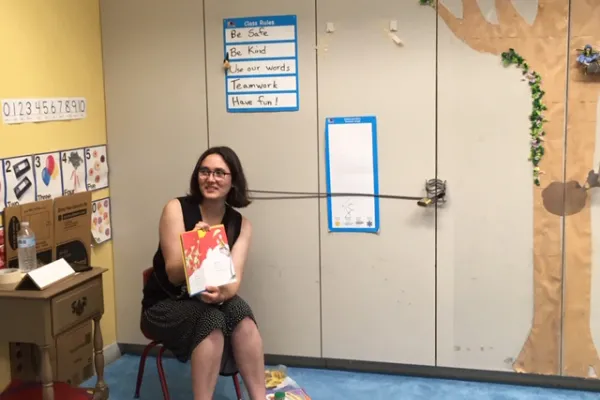Summer School for Smith Students—as Teachers
Smith & Northampton

Published July 25, 2019
Holding a Dr. Seuss book in her hand, Tati Galli MAT ’20 leans forward to address a group of youngsters gathered around her in a sunny ground-floor classroom at Bridge Street Elementary School in Northampton.
“I’m going to read you all a story,” she says. “It sounds like a poem!”
Galli, who is volunteering this summer in the city schools, reads a few pages of One Fish Two Fish Red Fish Blue Fish, then stops to let the children respond.
“What do you see going on here?” she asks them.
“He’s brushing his hair,” replies one little boy.
“Because it’s very long,” adds a classmate.
This is the first summer that Smith students have been invited to participate in a decades-old city schools program aimed at helping children with special educational needs. About 100 children in kindergarten through 8th grade are enrolled in the half-day summer program at Bridge Street and JFK Middle School that runs through July.
Northampton Schools Superintendent John Provost says the goal of the program is to help students with disabilities maintain their learning momentum.
“We want to help bolster children against learning loss over the summer,” he says. “The Smith students are helping us keep students engaged with academic skills in a more laid-back classroom environment.”
The summer collaboration comes as Smith has launched a program to prepare graduate education students to become licensed teachers of children with moderate disabilities.
“So many of our schools—including Northampton—are going to an inclusion model,” where special education students are integrated in typical classrooms, notes Sam Intrator, Smith’s Elizabeth A. Woodson ’22 Professor of Education and Child Study. “The dual certification program allows us to respond to those needs.”
Gina Wyman, a lecturer in education and child study, took the lead on reaching out to the public schools about Smith students participating in the summer program for special education students.
“It’s a great connection for us,” Wyman says. “And the program supports an inclusion model that is becoming more widespread nationally.”
Sophia Glading-DiLorenzo, MAT ’20, says the new dual-certification training is part of what drew her to Smith’s graduate education program.
“Moderate disabilities is an up-and-coming area,” says Glading-DiLorenzo, who is getting hands-on training this summer interning in the Springfield public schools and with Smith’s Project Coach. “More kids are getting tested and evaluated for learning disabilities Also, a lot of English language learners are marked as having disabilities.”
Her own experience of coping with a learning disability that wasn’t diagnosed until high school has made Glading-DiLorenzo sympathetic to the needs of young students.
“I know how to get through to people,” she says, with a smile. “Because of the troubles I had in school, I can be a positive role model and help motivate these kids.”
For her part, Galli says she’s absorbed some important lessons working with children in the summer program at Bridge Street.
“I’m learning a lot about interacting with patience,” says Galli, who wants to become an educational researcher after she earns her Smith degree. “I’ve learned to observe and ask questions in trying to understand where the children are coming from.”
Pam Plumer, director of student services for the Northampton schools, says having Smith students participate in the summer program benefits everyone.
“The Smith students bring fresh energy and a real responsiveness to our students,” Plumer says. “And the program is a great opportunity for the Smith students to really figure out their niche.”